[English] 日本語
 Yorodumi
Yorodumi- PDB-6dzw: Cryo-EM structure of the ts2-inactive human serotonin transporter... -
+ Open data
Open data
- Basic information
Basic information
| Entry | Database: PDB / ID: 6dzw | |||||||||
|---|---|---|---|---|---|---|---|---|---|---|
| Title | Cryo-EM structure of the ts2-inactive human serotonin transporter in complex with paroxetine and 15B8 Fab and 8B6 ScFv | |||||||||
 Components Components |
| |||||||||
 Keywords Keywords | TRANSPORT PROTEIN/IMMUNE SYSTEM / paroxetine / antidepressant / human serotonin transporter / Fab / TRANSPORT PROTEIN-IMMUNE SYSTEM complex | |||||||||
| Function / homology |  Function and homology information Function and homology informationnegative regulation of cerebellar granule cell precursor proliferation / regulation of thalamus size / Serotonin clearance from the synaptic cleft / serotonergic synapse / positive regulation of serotonin secretion / cocaine binding / negative regulation of synaptic transmission, dopaminergic / sperm ejaculation / serotonin:sodium:chloride symporter activity / cellular response to cGMP ...negative regulation of cerebellar granule cell precursor proliferation / regulation of thalamus size / Serotonin clearance from the synaptic cleft / serotonergic synapse / positive regulation of serotonin secretion / cocaine binding / negative regulation of synaptic transmission, dopaminergic / sperm ejaculation / serotonin:sodium:chloride symporter activity / cellular response to cGMP / enteric nervous system development / sodium ion binding / negative regulation of organ growth / serotonin uptake / neurotransmitter transmembrane transporter activity / monoamine transmembrane transporter activity / serotonin binding / monoamine transport / conditioned place preference / vasoconstriction / brain morphogenesis / neurotransmitter transport / syntaxin-1 binding / antiporter activity / amino acid transport / nitric-oxide synthase binding / behavioral response to cocaine / membrane depolarization / social behavior / negative regulation of neuron differentiation / sodium ion transmembrane transport / endomembrane system / positive regulation of cell cycle / monoatomic cation channel activity / cellular response to retinoic acid / response to nutrient / platelet aggregation / memory / response to toxic substance / circadian rhythm / actin filament binding / integrin binding / response to estradiol / presynaptic membrane / postsynaptic membrane / response to hypoxia / endosome membrane / neuron projection / response to xenobiotic stimulus / membrane raft / focal adhesion / synapse / positive regulation of gene expression / identical protein binding / plasma membrane Similarity search - Function | |||||||||
| Biological species |  Homo sapiens (human) Homo sapiens (human) | |||||||||
| Method | ELECTRON MICROSCOPY / single particle reconstruction / cryo EM / Resolution: 4.3 Å | |||||||||
 Authors Authors | Coleman, J.A. / Yang, D. / Gouaux, E. | |||||||||
| Funding support |  United States, 2items United States, 2items
| |||||||||
 Citation Citation |  Journal: Nature / Year: 2019 Journal: Nature / Year: 2019Title: Serotonin transporter-ibogaine complexes illuminate mechanisms of inhibition and transport. Authors: Jonathan A Coleman / Dongxue Yang / Zhiyu Zhao / Po-Chao Wen / Craig Yoshioka / Emad Tajkhorshid / Eric Gouaux /  Abstract: The serotonin transporter (SERT) regulates neurotransmitter homeostasis through the sodium- and chloride-dependent recycling of serotonin into presynaptic neurons. Major depression and anxiety ...The serotonin transporter (SERT) regulates neurotransmitter homeostasis through the sodium- and chloride-dependent recycling of serotonin into presynaptic neurons. Major depression and anxiety disorders are treated using selective serotonin reuptake inhibitors-small molecules that competitively block substrate binding and thereby prolong neurotransmitter action. The dopamine and noradrenaline transporters, together with SERT, are members of the neurotransmitter sodium symporter (NSS) family. The transport activities of NSSs can be inhibited or modulated by cocaine and amphetamines, and genetic variants of NSSs are associated with several neuropsychiatric disorders including attention deficit hyperactivity disorder, autism and bipolar disorder. Studies of bacterial NSS homologues-including LeuT-have shown how their transmembrane helices (TMs) undergo conformational changes during the transport cycle, exposing a central binding site to either side of the membrane. However, the conformational changes associated with transport in NSSs remain unknown. To elucidate structure-based mechanisms for transport in SERT we investigated its complexes with ibogaine, a hallucinogenic natural product with psychoactive and anti-addictive properties. Notably, ibogaine is a non-competitive inhibitor of transport but displays competitive binding towards selective serotonin reuptake inhibitors. Here we report cryo-electron microscopy structures of SERT-ibogaine complexes captured in outward-open, occluded and inward-open conformations. Ibogaine binds to the central binding site, and closure of the extracellular gate largely involves movements of TMs 1b and 6a. Opening of the intracellular gate involves a hinge-like movement of TM1a and the partial unwinding of TM5, which together create a permeation pathway that enables substrate and ion diffusion to the cytoplasm. These structures define the structural rearrangements that occur from the outward-open to inward-open conformations, and provide insight into the mechanism of neurotransmitter transport and ibogaine inhibition. | |||||||||
| History |
|
- Structure visualization
Structure visualization
| Movie |
 Movie viewer Movie viewer |
|---|---|
| Structure viewer | Molecule:  Molmil Molmil Jmol/JSmol Jmol/JSmol |
- Downloads & links
Downloads & links
- Download
Download
| PDBx/mmCIF format |  6dzw.cif.gz 6dzw.cif.gz | 190 KB | Display |  PDBx/mmCIF format PDBx/mmCIF format |
|---|---|---|---|---|
| PDB format |  pdb6dzw.ent.gz pdb6dzw.ent.gz | 146 KB | Display |  PDB format PDB format |
| PDBx/mmJSON format |  6dzw.json.gz 6dzw.json.gz | Tree view |  PDBx/mmJSON format PDBx/mmJSON format | |
| Others |  Other downloads Other downloads |
-Validation report
| Summary document |  6dzw_validation.pdf.gz 6dzw_validation.pdf.gz | 1.3 MB | Display |  wwPDB validaton report wwPDB validaton report |
|---|---|---|---|---|
| Full document |  6dzw_full_validation.pdf.gz 6dzw_full_validation.pdf.gz | 1.3 MB | Display | |
| Data in XML |  6dzw_validation.xml.gz 6dzw_validation.xml.gz | 41.3 KB | Display | |
| Data in CIF |  6dzw_validation.cif.gz 6dzw_validation.cif.gz | 60.2 KB | Display | |
| Arichive directory |  https://data.pdbj.org/pub/pdb/validation_reports/dz/6dzw https://data.pdbj.org/pub/pdb/validation_reports/dz/6dzw ftp://data.pdbj.org/pub/pdb/validation_reports/dz/6dzw ftp://data.pdbj.org/pub/pdb/validation_reports/dz/6dzw | HTTPS FTP |
-Related structure data
| Related structure data |  8941MC  0437C  8940C  8942C  8943C 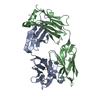 6d9gC  6dzvC  6dzyC  6dzzC M: map data used to model this data C: citing same article ( |
|---|---|
| Similar structure data |
- Links
Links
- Assembly
Assembly
| Deposited unit | 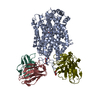
|
|---|---|
| 1 |
|
- Components
Components
-Antibody , 3 types, 3 molecules VHL
| #2: Antibody | Mass: 26220.395 Da / Num. of mol.: 1 Source method: isolated from a genetically manipulated source Source: (gene. exp.)   |
|---|---|
| #3: Antibody | Mass: 12980.533 Da / Num. of mol.: 1 Source method: isolated from a genetically manipulated source Source: (gene. exp.)   |
| #4: Antibody | Mass: 11776.065 Da / Num. of mol.: 1 Source method: isolated from a genetically manipulated source Source: (gene. exp.)   |
-Protein / Non-polymers , 2 types, 2 molecules A

| #1: Protein | Mass: 60479.430 Da / Num. of mol.: 1 Source method: isolated from a genetically manipulated source Source: (gene. exp.)  Homo sapiens (human) / Gene: SLC6A4, HTT, SERT / Production host: Homo sapiens (human) / Gene: SLC6A4, HTT, SERT / Production host:  Homo sapiens (human) / References: UniProt: P31645 Homo sapiens (human) / References: UniProt: P31645 |
|---|---|
| #6: Chemical | ChemComp-8PR / |
-Sugars , 2 types, 2 molecules 
| #5: Polysaccharide | 2-acetamido-2-deoxy-beta-D-glucopyranose-(1-4)-2-acetamido-2-deoxy-beta-D-glucopyranose Source method: isolated from a genetically manipulated source |
|---|---|
| #7: Sugar | ChemComp-NAG / |
-Details
| Has protein modification | Y |
|---|
-Experimental details
-Experiment
| Experiment | Method: ELECTRON MICROSCOPY |
|---|---|
| EM experiment | Aggregation state: PARTICLE / 3D reconstruction method: single particle reconstruction |
- Sample preparation
Sample preparation
| Component |
| ||||||||||||||||||||||||||||||
|---|---|---|---|---|---|---|---|---|---|---|---|---|---|---|---|---|---|---|---|---|---|---|---|---|---|---|---|---|---|---|---|
| Source (natural) |
| ||||||||||||||||||||||||||||||
| Source (recombinant) |
| ||||||||||||||||||||||||||||||
| Buffer solution | pH: 8 | ||||||||||||||||||||||||||||||
| Specimen | Embedding applied: NO / Shadowing applied: NO / Staining applied: NO / Vitrification applied: YES | ||||||||||||||||||||||||||||||
| Specimen support | Details: unspecified | ||||||||||||||||||||||||||||||
| Vitrification | Cryogen name: ETHANE |
- Electron microscopy imaging
Electron microscopy imaging
| Experimental equipment |  Model: Titan Krios / Image courtesy: FEI Company |
|---|---|
| Microscopy | Model: FEI TITAN KRIOS |
| Electron gun | Electron source:  FIELD EMISSION GUN / Accelerating voltage: 300 kV / Illumination mode: FLOOD BEAM FIELD EMISSION GUN / Accelerating voltage: 300 kV / Illumination mode: FLOOD BEAM |
| Electron lens | Mode: BRIGHT FIELD |
| Image recording | Electron dose: 50 e/Å2 / Film or detector model: GATAN K2 SUMMIT (4k x 4k) |
- Processing
Processing
| CTF correction | Type: PHASE FLIPPING ONLY |
|---|---|
| 3D reconstruction | Resolution: 4.3 Å / Resolution method: FSC 0.143 CUT-OFF / Num. of particles: 214537 / Symmetry type: POINT |
| Refinement | Highest resolution: 4.3 Å |
 Movie
Movie Controller
Controller


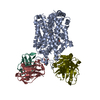




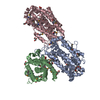
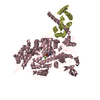
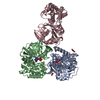
 PDBj
PDBj






